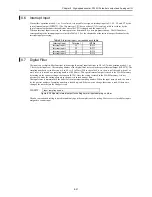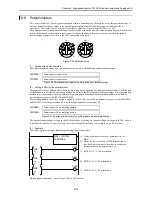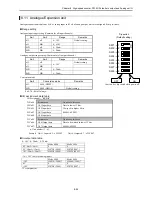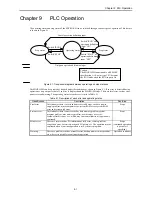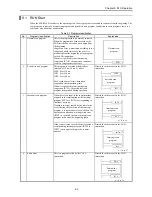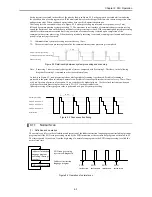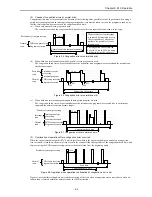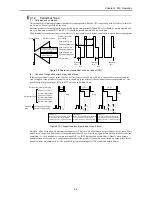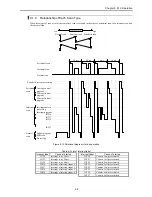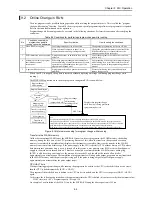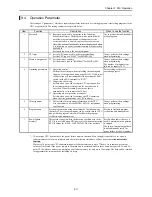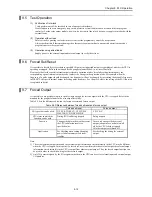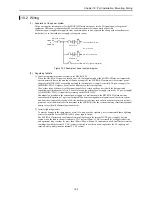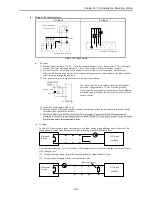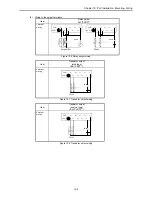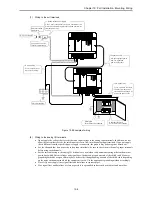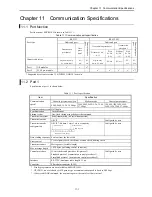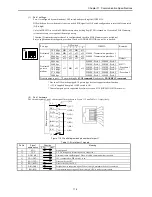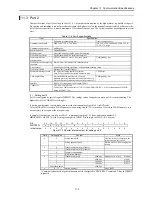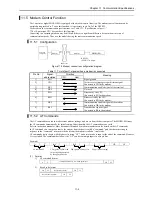
Chapter 9 PLC Operation
9-11
9.4
Operation Parameter
The settings of “parameters,” which are required to perform tasks such as creating programs, transferring programs to the
CPU, are performed. The setting contents are explained below.
Item
Function
Description
When to use the function
1
Password
{
Register a password to a program in the four-digit
hexadecimal format. The program with a password will
not allow program operation nor changes unless the
correct password is entered, so please exercise caution.
Note: The user will not be able to reset the password when
it is forgotten, so exercise extreme caution when accessing
a password.
Password is not set at the time of shipment.
Use to protect the confidentiality
of the programs.
2
CPU type
{
Set the CPU name used to perform programming.
Set the CPU type to “H-302” for MICRO-EH.
Always perform these settings
when programming.
3
Memory assignment
{
Set the memory capacity.
Set the memory type to “RAM-04H” for MICRO-EH.
Always perform these settings
when programming.
The number of program steps
that can be input is 3072.
4
Operating parameters
{
Operation control
Perform these settings when controlling the running and
stopping of the operation using a specific I/O. If this is not
set, operation will start automatically by setting the RUN
switch (or the RUN terminal) to “RUN.”
{
Congestion check time
Set this when you wish to stop the CPU operation when
the set maximum processing time for a normal scan is
exceeded. When this setting is not made, this is
automatically set to initial value 100 ms.
{
Operating mode at problem occurrence
Set this when you wish to continue the CPU operation
when the error generated by the CPU is minor.
Set according to the user's
operation purposes.
5
I/O assignment
{
This sets the I/O assignment information of the CPU.
It is convenient to use the MICRO-EH's I/O assignment
copy function.
Always perform these settings
when programming.
6
Program name
Set the program name using a maximum of 16 alphanumeric
characters. The set program names can be written into the CPU
along with the program, which will facilitate the program
verification and management.
Set this to facilitate program
verification and management.
7
Power failure
memory*
This sets the range in which the data in a specified area in the
CPU is to be stored upon CPU power off or when commencing
RUN. Settings for R, WR, WM, TD, DIF, DFN are possible.
Set this when there is data you
wish to maintain when operation
is stopped.
The special internal output data
is unconditionally saved for
power failure by the I/O number.
*: 10-point type CPU does not have the power failure memory function. Even though it is possible to set a power
failure memory area from a peripheral unit, the values that are stored here will not be persistent;
do not set this
function.
Moreover, 14-point type CPU can maintain power failure memory only up to 72 hours. Note that non-persistent
values will be stored if the power supply to the main unit is not turned on after these hours have passed. 23- and 28-
point CPUs without a battery can maintain power failure memory for only up to 30 minutes. The data can be retained
for approximately two months by installing a battery.
Summary of Contents for HIDIC MICRO-EH
Page 1: ...HITACHI PROGRAMMABLE CONTROLLER APPLICATION MANUAL NJI 350B X ...
Page 12: ...MEMO ...
Page 14: ...Chapter 1 Features 1 2 MEMO ...
Page 50: ...Chapter 4 Product lineup and wiring 4 18 MEMO ...
Page 196: ...Chapter 5 Instruction Specifications 5 146 ...
Page 263: ...Chapter 11 Communication Specifications 11 10 MEMO ...

